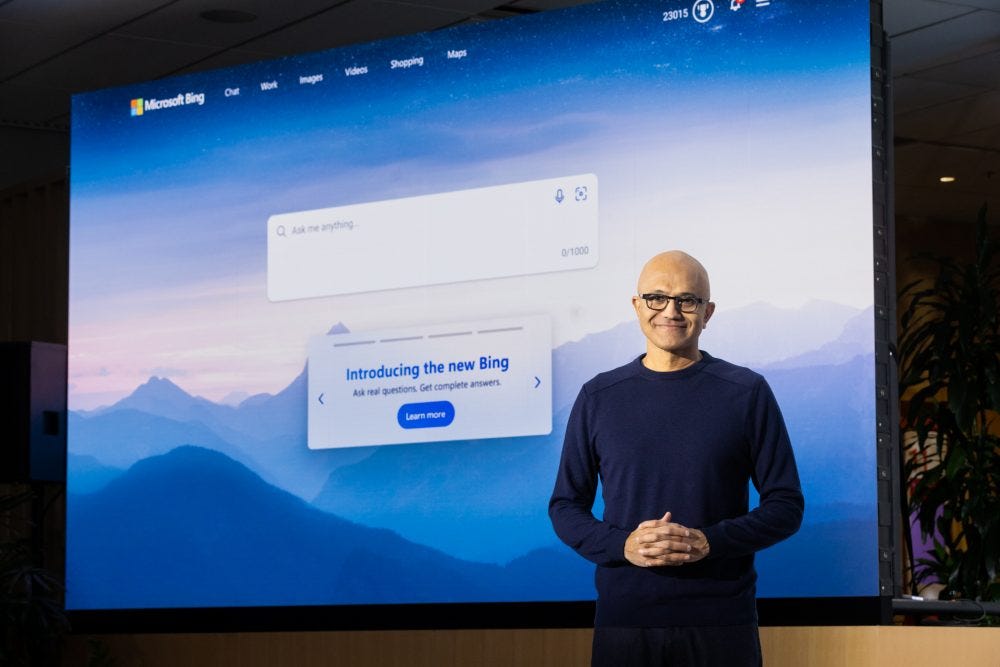Welcome to Mostly Cloudy! Today: how generative AI is speedrunning the Gartner Hype Cycle, more enterprise tech companies join the 7% and Up Club, and what’s next for former Salesforce CEO Bret Taylor.
Photo: Dan DeLong/Microsoft
Neurotic networks
Tech companies and investors have been increasingly desperate over the last several years to deliver a true game-changing technology, something along the lines of how smartphones and cloud computing reordered the existing power structure 15 years ago. That desperation has produced self-driving cars that can’t really drive themselves, a financial-system revolution built on quicksand, and, now, generative AI, a system supposedly so powerful that a delusional Google engineer was fired for believing it was a living being.
This week Microsoft continued to execute a well-planned hype campaign around what it sees as that big breakthrough: Generative AI, the technology delivered by its partnership with OpenAI to serve as the foundation for a relaunch of Bing, the supposed Google-killer search engine that helped accelerate Steve Ballmer’s demise as much as any one thing. No one disputes that internet search has grown stodgy, choked with ads and irrelevant information, but CEO Satya Nadella believes that OpenAI’s technology will do more than just reinvigorate search.
“This technology will reshape pretty much every software category that we know,” Nadella said in an interview with the New York Times. That’s a bold claim for something that has produced unreliable results at the rate that OpenAI’s technology has, but as noted earlier this year, Nadella is certainly privy to OpenAI’s future roadmap.
It’s one thing for prompt-based search to return compelling, comprehensive snippets of information in a controlled, limited preview that predictably dazzled those invited to the Bing 2.0 coming-out party. It’s a little harder to see how large-language models will overturn software development practices in short order, and Nadella stayed focused on search during this week’s presentation.
GitHub Copilot is certainly one example of how that prediction could come true. While the legal implications of its coding assistant will take some time to play out before enterprises feel comfortable adopting it en masse, developers are clearly “shadow coding” with the technology much the same way their older cousins made clandestine cloud computing a real phenomenon long before it saw mainstream success.
Beyond that, it’s a little fuzzier.
Stephen O’Grady of Redmonk took a stab at articulating that future earlier this month, showing how with a few improvements generative AI prompts could be used as a new user interface for developers struggling to manage the complexity of modern software development and deployment. In other words, this could be the technology that the low-code movement has been waiting for.
But thanks to breathless hype from Microsoft and those that like to front-run emerging technologies to kick off 2023, generative AI technology is speedrunning the Gartner Hype Cycle like few things we’ve seen in recent time. Case in point: Marc Benioff pre-announcing “Salesforce EinsteinGPT” this week, which, if it’s not an early April Fool’s joke, is just kind of sad.
Change comes slowly to the enterprise, no matter how many shiny new things vendors present as magic beans. As this hype cycle plays out, don’t forget that all these enterprise tech vendors — the ones so confident that they understand where the puck is going — just laid off tens of thousands of workers because their data-driven operational decision-making systems were unable to recognize that pandemic-fueled demand for their services was a mirage.
No layoff to layoffs
Three new enterprise tech companies became the latest to lay off significant portions of their employees this week, citing *gestures wildly at macroeconomic chart.*
Perhaps most predictably, Zoom announced a 15% cut after failing to transform one of the most clear examples of pandemic-driven demand for its video-conferencing services into new areas.
GitHub cut 10% of its staff and announced plans to become a remote-only workplace in order to save costs. It’s not clear if those cuts are part of the broader cuts announced by parent company Microsoft earlier this year.
GitLab cut 7% of its employees. “I had hoped reprioritizing our spending would be enough to withstand the growing global economic downturn,” CEO Sid Sijbrandij told employees, but it was not.
We’re almost midway through the first quarter of 2023, and it’s hard to believe that tech companies are done cutting employees after AWS warned that it expects revenue growth to slow during the current period.
Around the enterprise
Bret Taylor will join longtime Googler Clay Bavor in a new startup that will “apply AI to solve some of the most important problems in business.”
Cloudflare owned up to incorrectly throttling a customer’s website after mistakenly thinking the customer had violated its terms of service, and outlined plans to prevent it from happening again.
How many enterprise workloads have actually moved to the cloud? The Next Platform did some back-of-the-envelope math and concluded the answer is more than what you might hear from cloud providers talking up their future growth.
Arm-based server processors now handle 5% of Big Three cloud workloads, according to Softbank, which is prepping Arm for an IPO later this year.
Thanks for reading — see you next week!

